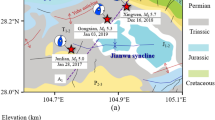Abstract
The method for constructing the generalized vicinity of a large earthquake as put forward and implemented in (Rodkin, 2008, 2012, 2020; Rodkin and Tikhonov, 2016) was previously used for analysis of world earthquake catalogs only. The use of this method for the analysis of regional catalogs presupposes a lower magnitude threshold for classification of large events and incorporation of regional seismicity peculiarities. We constructed the generalized vicinity from regional data for the Kuril Islands and Kamchatka. The same seismicity features have been identified as those for the generalized vicinity based on worldwide data; in particular, we identified the effect of earthquake hypocenters getting shallower in the near vicinity of a large earthquake. However, the regional data revealed the unexpected effect of a temporary clustering of large earthquakes, including those cases where they were far from each other. The volumes of higher activity involve considerable parts of the subduction zone far from each other both along the trench and over depth. We have estimated characteristic parameters of these clusters and the fraction of statistically dependent and independent large events. The mutual influence of seismicity at different depths has been discussed.








Similar content being viewed by others
REFERENCES
Andreeva, M.Yu. and Kim, Ch.U., Zemletryaseniya Kurilo-Kamchatskogo regiona (1737–2009 gg.) (Earthquakes in the Kuril–Kamchatka Region, 1737–2009), Yuzhno-Sakhalinsk: IMGiG DVO RAN, 2012.
Baranov, B.V., Vikulin, A.V., and Lobkovski, A.V., Shallow seismicity in the Kuril–Kamchatka backarc region and its relationship to large earthquakes in the subduction zone, Vulkanol. Seismol., 1989, no. 6, pp. 73‒84.
Bath, M., Lateral inhomogeneities in the upper mantle, Tectonophysics, 1965, vol. 2, pp. 483‒514.
Godano, C., A new expression for the earthquake interevent time distribution, Geophys. J. Int., 2015, vol. 202, pp. 219‒223.
ISC = [International Seismological Centre].URL: http://www.isc.ac.uk/iscbulletin/search/catalogue/. html (as of March 16, 2020).
Marzocchi, W. and Sandri, L., A review and new insights in the estimation of b-value and its uncertainty, Ann. Geophys., 2003, vol. 46, pp. 1271‒1282.
Rodkin, M.V., Seismicity in the generalized vicinity of large earthquakes, J. Volcanol. Seismol., 2008, vol. 2, no. 6, pp. 435–445.
Rodkin, M.V., Patterns of seismicity found in the generalized vicinity of a strong earthquake: Agreement with common scenarios of instability development, in Extreme Events and Natural Hazards, The Complexity Perspective, Geophys. Monogr. Ser., Sharma, A.S., et al., Eds., Washington, D.C.: AGU, 2012, vol. 196, pp. 27‒39. https://doi.org/10.1029/2011GM001060.
Rodkin, M.B., A typical foreshock and aftershock anomaly: Observations, interpretation, and applications, J. Volcanol. Seismol., 2020, vol. 14, no. 1, pp. 58–82.
Rodkin, M.V. and Tikhonov, I.N., The typical seismic behavior in the vicinity of a large earthquake, Physics and Chemistry of the Earth, 2016, vol. 95, pp. 73‒84.
Rogozhin, E.A., The seismotectonics of the central sector of the Greater Caucasus as a basis for seismic monitoring and hazard assessment, Vestnik Vladikavkazskogo Nauchnogo Tsentra, 2009, vol. 9, no. 4, pp. 16‒22.
Sasorova, E.V., Andreeva, M.Yu., and Levin, B.W., Dynamics of the seismicity of the Kuril arc based on multivariate statistical analysis, Russian Journal of Pacific Geology, 2013, vol. 7, no. 1, pp. 56‒64. https://doi.org/10.1134/S1819714013010077
Shcherbakov, R. and Turcotte, D.L., A modified form of Bath’s law, Bull. Seismol. Soc. Am., 2004, vol. 5, no. 94, pp. 1968‒1975.
Smirnov, V.B., Ommi, S., Potanina, M.G., Mikhailov, V.O., Petrov, A.G., Shapiro, N.M., and Ponomarev, A.V., Estimating the parameters of the failure cycle in the lithosphere based on regional earthquake catalogs, Fizika Zemli, 2019, no. 5, pp. 3‒21.
Sobolev, G.A., Osnovy prognoza zemletryasenii (Principles of Earthquake Prediction), Moscow: Nauka, 1993.
Tarakanov, R.Z., Seismicheskii potentsial Kurilsko-Okhotskogo regiona. Problemy seismicheskoi opasnosti Dalnevostochnogo regiona (The Seismic Potential of the Kuril–Okhotsk Region. Problems in Seismic Hazard for the Russian Far East Region), in Geodinamika tektonosfery zony sochleneniya Tikhogo okeana s Evraziei (The Tectonosphere Geodynamics in the Junction Zone between the Pacific Ocean and Eurasia), vol. VI, Yuzhno-Sakhalinsk: Institut Morskoi Geologii i Geofiziki DVO RAN, 1997.
Tarakanov, R.Z. and Andreeva, M.Yu., The role of the seismic dipping zone in the formation and evolution of geological features in the Kuril–Okhotsk region, Tikhookean. Geol., 2012, vol. 31, no. 6, pp. 87‒96.
Utsu, T., A method for determining the value of b in a formula log n = a – bM showing the magnitude-frequency relation for earthquakes, Geophys. Bull. Hokkaido Univ., 1965, vol. 13, pp. 99‒103 (In Japanese).
Zakharova, A.I. and Rogozhin, E.A., Deep-focus precursors of large seismic events in Kamchatka, in Geofizika na rubezhe vekov (Geophysics at the Turn of the Century), Selected Works of Researchers at the OIFZ RAN, Moscow: OIFZ RAN, 1999, pp. 265‒275.
Zakharova, A.I. and Rogozhin, E.A., Space–time relationships between the rupture zones of large earthquakes and their deep-focus precursors, in Issledovaniya v oblasti geofiziki (Research in Geophysics), 75 Years of the United Institute of Physics of the Earth, Moscow: OIFZ RAN, 2004, pp. 13‒19.
Funding
This work was carried out for a state assignment of the Institute of Earthquake Prediction Theory and Mathematical Geophysics, Russian Academy of Sciences (topic AAAA-A19-119011490129-0) and of the Institute of Marine Geology and Geophysics, Far East Branch, Russian Academy of Sciences (topic AAAA-A18-118012290125-2.2), and was supported by the Russian Foundation for Basic Research, project no. 19-05-00466.
Author information
Authors and Affiliations
Corresponding author
Additional information
Translated by A. Petrosyan
Rights and permissions
About this article
Cite this article
Rodkin, M.V., Andreeva, M.Y. & Grigorieva, O.O. An Analysis of the Generalized Vicinity of a Large Earthquake Using Regional Data: The Kuril–Kamchatka Region. J. Volcanolog. Seismol. 14, 410–419 (2020). https://doi.org/10.1134/S074204632006007X
Received:
Revised:
Accepted:
Published:
Issue Date:
DOI: https://doi.org/10.1134/S074204632006007X




